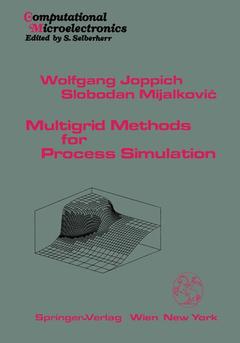Multigrid Methods for Process Simulation, Softcover reprint of the original 1st ed. 1993 Computational Microelectronics Series
Langue : Anglais
Auteurs : Joppich Wolfgang, Mijalkovic Slobodan

It was about 1985 when both of the authors started their work using multigrid methods for process simulation problems. This happened in dependent from each other, with a completely different background and different intentions in mind. At this time, some important monographs appeared or have been in preparation. There are the three "classical" ones, from our point of view: the so-called "1984 Guide" [12J by Brandt, the "Multi-Grid Methods and Applications" [49J by Hackbusch and the so-called "Fundamentals" [132J by Stiiben and Trottenberg. Stiiben and Trottenberg in [132J state a "delayed acceptance, resent ments" with respect to multigrid algorithms. They complain: "Nevertheless, even today's situation is still unsatisfactory in several respects. If this is true for the development of standard methods, it applies all the more to the area of really difficult, complex applications." In spite of all the above mentioned publications and without ignoring important theoretical and practical improvements of multigrid, this situa tion has not yet changed dramatically. This statement is made under the condition that a numerical principle like multigrid is "accepted", if there exist "professional" programs for research and production purposes. "Professional" in this context stands for "solving complex technical prob lems in an industrial environment by a large community of users". Such a use demands not only for fast solution methods but also requires a high robustness with respect to the physical parameters of the problem.
1 Introduction.- 2 A Practical Guide to Standard Multigrid Methods.- 2.1 Continuous and Discrete Model Problems.- 2.1.1 Basic Iterative Schemes.- 2.1.2 Convergence Analysis in Practice.- 2.1.3 Convergence Analysis for Gauss-Seidel and Jacobi Methods.- 2.1.4 Practical Analysis of Iterative Schemes.- 2.2 The Multigrid Principle.- 2.2.1 From the Coarse Grid Correction Idea to the Multigrid Correction Scheme.- 2.3 The Components of the Algorithm.- 2.4 Multigrid Strategies for Model Problems—Complete Algorithms.- 2.5 The Full Approximation Scheme.- 2.6 Full Multigrid.- 2.7 Multigrid Methods for Refined Grids.- 2.7.1 Multilevel Adaptive Technique, MLAT.- 2.7.2 An Easy to Determine Refinement Criterion.- 2.7.3 ?-FMG.- 2.7.4 The Fast Adaptive Composite Grid Method, FAC.- 2.8 Parabolic Initial Boundary Value Problems.- 2.9 Systems of Partial Differential Equations.- 2.10 Tools to Estimate Multigrid Convergence.- 2.10.1 Two-Grid Analysis—Global.- 2.10.2 Two-Grid Analysis—Local.- 2.10.3 Smoothing Analysis.- 2.11 Multigrid on Parallel Computers.- 2.11.1 Speed-Up and Efficiency.- 2.11.2 Criteria for Efficient Parallel Algorithm Development.- 2.11.3 Grid Partitioning—An Efficient Parallelization Concept for Multigrid.- 2.11.4 Parallel Performance of Multigrid for Poisson’s Equation.- 2.11.5 Other Parallelization Concepts.- 2.11.6 Parallelization of Non-Local Smoothing Operators.- 2.12 Standard Multigrid for Semiconductor Device Simulation.- 3 Adaptive Multilevel Grid Selection Strategies for Process Simulation Evolution Problems.- 3.1 Adaptive Multilevel Discrete Approximation.- 3.1.1 General Process Simulation Evolution Problems.- 3.1.2 Adaptive Multilevel Discrete Approximation in Space.- 3.1.3 Adaptive Temporal Discrete Approximation.- 3.2 Discretization Errors and Their Properties.- 3.2.1 Global and Local Errors.- 3.2.2 A Generalized Local Error.- 3.2.3 Local-Global Error.- 3.3 Evaluation of the Discretization Errors by Two-Level Extrapolation Techniques.- 3.3.1 Asymptotic Dependence of Discretization Errors on the Discretization Scale.- 3.3.2 Richardson Extrapolation Technique.- 3.3.3 ?-Extrapolation Technique.- 3.4 Local Refinement Criteria Based on Discretization Errors.- 3.5 Two-Level Time Stepping Schemes Based on Extrapolation Techniques.- 3.5.1 Technology of Adaptive Time-Step Size Control.- 3.5.2 Two-Level Step-Doubling Strategy.- 3.5.3 A Two-Level Strategy Based on ?-Extrapolation.- 4 Tayloring Multigrid Components for a Diffusion Model Problem.- 4.1 The Physical Problem and the Mathematical Representation.- 4.1.1 Implantation.- 4.1.2 Diffusion.- 4.1.3 Oxidation.- 4.1.4 The Mathematical Formulation of the Model Problem.- 4.2 The Discretization.- 4.2.1 Numerical Consequences of a Domain Transformation.- 4.2.2 The Discretization of the Diffusion Equation Including the Homogeneous Neumann Boundary Conditions.- 4.2.3 The Discrete Boundary Condition on the Time-Dependent Boundary.- 4.2.4 Time Discretization.- 4.2.5 Time Stepping.- 4.2.6 An Estimation of the Stability Condition for CN.- 4.3 Relaxation Methods.- 4.3.1 Gauss-Seidel-Newton Relaxations.- 4.3.2 Relaxation Schemes.- 4.3.3 Empirical Convergence Rates.- 4.4 Results of the Smoothing Analysis with Respect to Time-Step Size.- 4.5 Experiments with the Crank-Nicolson Scheme and with the Fully Implicit Scheme.- 4.6 The Prolongation of Grid Functions.- 4.6.1 Monotone Cubic Hermite-Interpolation.- 4.6.2 Monotone and Shape Preserving MG Interpolations.- 4.7 The Restriction of Approximations and of Residuais.- 4.8 Technical Aspects of Time-Dependent Refinements.- 4.9 Numerical Results for the Model Problem.- 4.9.1 Experiments on Global Grids—Standard Approach.- 4.9.2 Experiments on Global Grids—Improved Algorithm.- 4.9.3 Experiments Using Locally Refined Grids.- 4.9.4 The Relative Local Discretization Error on Refined Grids.- 4.9.5 CPU-Time Requirements.- 5 Procedures for Adaptive Multigrid Simulation of Evolution Processes.- 5.1 Practical Algorithmic and Programming Techniques for Multilevel Local Grid Refinement.- 5.1.1 Elementary Refinement Patches and a Basic Two-Level Local Grid Refinement Procedure.- 5.1.2 Efficient Data Structures for Spatial Local Refinement.- 5.2 The Adaptive Construction of an Initial State Discrete Approximation.- 5.2.1 A Procedure for the Adaptive Discrete Approximation of a Compact Initial State Distribution.- 5.2.2 A Procedure for Adaptive Superposition of Discrete and Compact Initial State Distributions.- 5.2.3 Examples of Ion-Implantation Process Modeling.- 5.3 Basic Procedures for the Adaptive Transient Simulation of Evolution Problems.- 5.3.1 Cycling Multigrid Solution Procedure with an Adaptive Iteration Stopping Criterion.- 5.3.2 The Local Refinement-Solution Procedure.- 5.3.3 Automatic Time Stepping Procedures in the Framework of Multilevel Spatial Grid Stuctures.- 5.3.4 An Example of Impurity Diffusion Simulation.- 5.4 Local Grid-Decomposition Algorithmic Strategy for Simulation of Multiparticle Evolution Processes.- 5.4.1 Multiparticle Process Simulation Challenges.- 5.4.2 An Adaptive Multigrid Algorithm with Local Grid Decomposition.- 5.4.3 An Example of Coupled Impurity Diffusion Simulation.- 5.4.4 An Example of Coupled Interstitial-Vacancy Diffusion Simulation During Local Oxidation.- 5.5 Simulation of Critical Process Simulation Steps of BiCMOS Technology—Case Study.- 5.5.1 Simulation of the Lightly Doped Drain (LDD) Structure for the NMOS Transistor.- 5.5.2 Simulation of the Base and Emitter of the NPN Bipolar Transistor.- 5.5.3 Simulation of the Buried Channel Low Doped Drain (BCLDD) Structure of the PMOS Transistor.- References.
Date de parution : 01-2012
Ouvrage de 309 p.
17x24.4 cm
Disponible chez l'éditeur (délai d'approvisionnement : 15 jours).
Prix indicatif 52,74 €
Ajouter au panierThème de Multigrid Methods for Process Simulation :
© 2024 LAVOISIER S.A.S.
